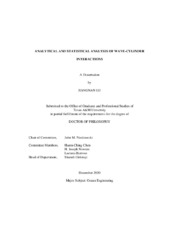| dc.contributor.advisor | Niedzwecki, John M | |
| dc.creator | Lu, Jiangnan | |
| dc.date.accessioned | 2021-05-07T00:23:13Z | |
| dc.date.available | 2022-12-01T08:19:41Z | |
| dc.date.created | 2020-12 | |
| dc.date.issued | 2020-10-30 | |
| dc.date.submitted | December 2020 | |
| dc.identifier.uri | https://hdl.handle.net/1969.1/192901 | |
| dc.description.abstract | Arrays of closely spaced slender cylindrical-shaped structural elements such as marine risers, TLP tendons, and horizontal pipelines are widely used in many offshore applications. Their response behavior subjected to random waves and current loadings is very complicated and remains an important area for further research. The goal of this research study is two-fold. First it seeks to investigate the possibility of using analytical models as a simple design approach to bound drag force coefficients referred to in design practice, and secondly it pursues a general extremal statistical methodology for the analysis and characterization of industrial-scale model basin test data and field measurements.
Initially, this research investigated the Huse-Muren wake flow model that addressed the interaction of a slender vertical cylinder subject to a harmonically oscillatory flow in the drag-dominated force regime. Analysis of their model led to the formulation of a dimensionless drag coefficient correction ratio. Unfortunately, investigation based on published guidelines and measured data indicated that their model seemed to bound the data for a limited range of applications. For the crossflow formulation, new dimensionless parameters were formulated to better illustrate the impact of the transverse current on the drag coefficient correction ratio. A numerical simulation was subsequently performed, and the results were presented and discussed.
In the second phase of the research, a statistical methodology was formulated based on the generalized extreme value family of distributions for the characterization of in-line interactions of closely spaced two- and three- deep-water cylinder arrays. The most appropriate block size and the corresponding statistical models were selected by an iterative process that utilized Anderson-Darling test criterion, quantile plots, and histograms. The models were found to fit the data excellently, and the roles of spacings and top tensions on the risk of collision were characterized. An unexpected phenomenon in the observed data was successfully identified.
Finally, the flow-induced vibration response behavior of a flexible horizontal cylinder subject to both random waves and constant current conditions was investigated. The measured mid-span displacement was initially analyzed using standard spectral analyses to relate the cylinder’s response behavior to traditional deterministic parameters, whose values illustrated significant scatter. Further analyses were performed using the general statistical methodology, which was observed to provide good to excellent results for the random wave cases and at least moderately good results for the combined random wave and constant current cases. | en |
| dc.format.mimetype | application/pdf | |
| dc.language.iso | en | |
| dc.subject | wake flow models | en |
| dc.subject | vertical cylinders | en |
| dc.subject | drag coefficient correction ratio | en |
| dc.subject | wave and current cylinder interaction | en |
| dc.subject | generalized extremal value distribution | en |
| dc.subject | random waves | en |
| dc.subject | laboratory and field data characterization | en |
| dc.title | Analytical and Statistical Analysis of Wave-Cylinder Interactions | en |
| dc.type | Thesis | en |
| thesis.degree.department | Ocean Engineering | en |
| thesis.degree.discipline | Ocean Engineering | en |
| thesis.degree.grantor | Texas A&M University | en |
| thesis.degree.name | Doctor of Philosophy | en |
| thesis.degree.level | Doctoral | en |
| dc.contributor.committeeMember | Newton, H. Joseph | |
| dc.contributor.committeeMember | Barroso, Luciana | |
| dc.contributor.committeeMember | Chen, Hamn-Ching | |
| dc.type.material | text | en |
| dc.date.updated | 2021-05-07T00:23:14Z | |
| local.embargo.terms | 2022-12-01 | |
| local.etdauthor.orcid | 0000-0002-7569-4073 | |


